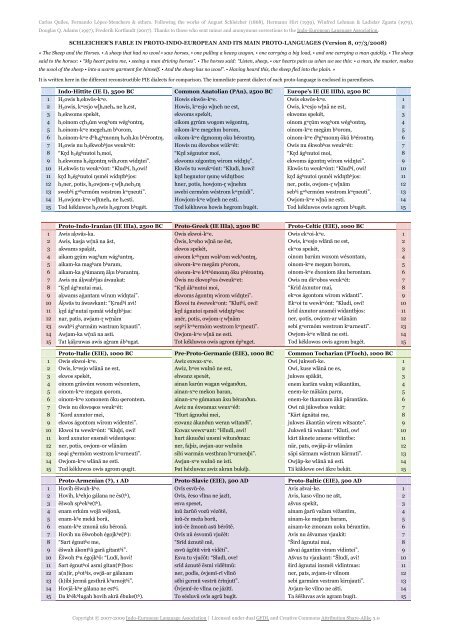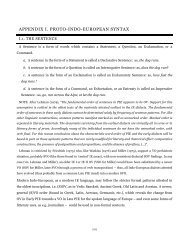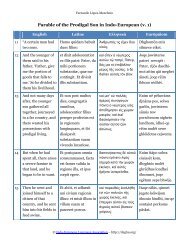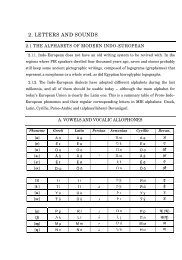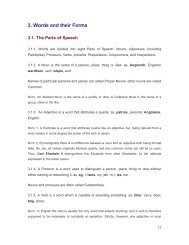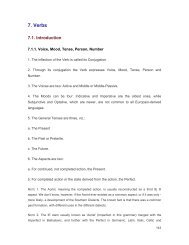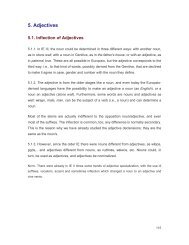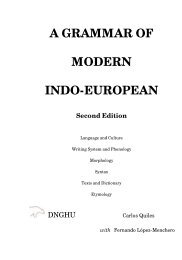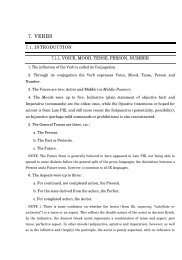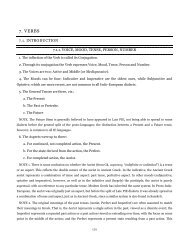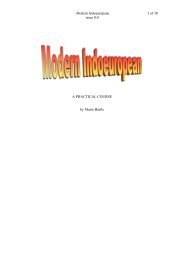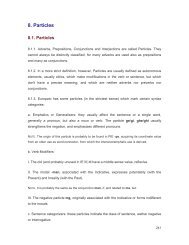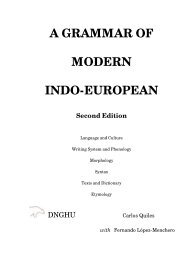Create successful ePaper yourself
Turn your PDF publications into a flip-book with our unique Google optimized e-Paper software.
Carlos Quiles, Fernando López-Menchero & others. Following the works of August Schleicher (1868), Hermann Hirt (1939), Winfred Lehman & Ladislav Zgusta (1979),<br />
Douglas Q. Adams (1997), Frederik Kortlandt (2007). Thanks to those who sent minor and anonymous corrections to the <strong>Indo</strong>-<strong>European</strong> Language Association.<br />
SCHLEICHER’S FABLE IN PROTO-INDO-EUROPEAN AND ITS MAIN PROTO-LANGUAGES (Version 8, 07/3/2008)<br />
« The Sheep and the Horses. • A sheep that had no wool • saw horses, • one pulling a heavy wagon, • one carrying a big load, • and one carrying a man quickly. • The sheep<br />
said to the horses: • “My heart pains me, • seeing a man driving horses”. • The horses said: “Listen, sheep, • our hearts pain us when we see this: • a man, the master, makes<br />
the wool of the sheep • into a warm garment for himself. • And the sheep has no wool”. • Having heard this, the sheep fled into the plain. »<br />
It is written here in the different reconstructible PIE dialects for comparison. The immediate parent dialect of each proto-language is enclosed in parentheses.<br />
<strong>Indo</strong>-<strong>Hittite</strong> (IE I), 3500 BC Common Anatolian (PAn), 2500 BC Europe’s IE (IE IIIb), 2500 BC<br />
1 H3owis h1ekwōs-kwe. Howis ekwōs-kwe. Owis ekwōs-kwe. 1<br />
2 H3owis, kwesjo wl̥h1neh2 ne h1est, Howis, kwesjo wl̥neh ne est, Owis, kwesjo wl̥̄nā<br />
ne est, 2<br />
3 h1ekwoms spekét, ekwoms spekét, ekwoms spekét, 3<br />
4 h1oinom cr̥h3úm woghom wéghontm̥, oikom gr̥rúm wogom wégontm̥, oinom gwr̥úm woghom wéghontm̥, 4<br />
5 h1oinom-kwe megeh2m bhorom, oikom-kwe megehm borom, oinom-kwe megām bhorom, 5<br />
6 h1oinom-kwe dhh1ghmonm̥ h1oh1ku bhérontm̥. oikom-kwe dgmonm̥ oku bérontm̥. oinom-kwe dhghmonm̥ ōkú bhérontm̥. 6<br />
7 H3owis nu h1ékwobhjos weukwét: Howis nu ékwobos wūkwét: Owis nu ékwobhos weukwét: 7<br />
8 “Kr̥d h2éghnutoi h1moí, “Kr̥d xégnutor moí, “Kr̥d ághnutoi moí, 8<br />
9 h1ekwoms h2égontm̥ wih1rom wídn̥tei”. ekwoms xégontm̥ wirom wídn̥tę”. ekwoms ágontm̥ wīrom wídn̥tei”. 9<br />
10 H1ekwōs tu weukwónt: “Kludhí, h3owi! Ekwōs tu weukwónt: “Kludí, howi! Ekwōs tu weukwónt: “Kludhí, owi! 10<br />
11 kr̥d h2éghnutoi n̥sméi wídn̥tbhjos: kr̥d hegnutor n̥smę wídn̥tbos: kr̥d ághnutoi n̥sméi wídn̥tbhjos: 11<br />
12 h2ner, potis, h3owjom-r̥ wl̥h1neh2m̥ hner, potis, howjom-r̥ wl̥nehm ner, potis, owjom-r̥ wl̥̄nām<br />
12<br />
13 swebhi gwhermóm westrom kwr̥neuti”. swebi cermóm wéstrom kwr̥nūdi”. sebhi gwhermóm westrom kwr̥neuti”. 13<br />
14 H3owjom-kwe wl̥hneh2 ne h1esti. Howjom-kwe wl̥neh ne esti. Owjom-kwe wl̥̄nā<br />
ne esti. 14<br />
15 Tod kékluwos h3owis h2egrom bhugét. Tod kékluwos howis hegrom bugét. Tod kékluwos owis agrom bhugét. 15<br />
Proto-<strong>Indo</strong>-Iranian (IE IIIa), 2500 BC Proto-Greek (IE IIIa), 2500 BC Proto-Celtic (EIE), 1000 BC<br />
1 Awis aķwās-ka. Owis ekwoi-kwe. Owis ekwoi-kwe. 1<br />
2 Awis, kasja wr̥̄nā<br />
na āst, Ówis, kweho wl̥̄nā<br />
ne ēst, Owis, kwesjo wlānā ne est, 2<br />
3 akwams spaķát, ekwos spekét, ekwos spekét, 3<br />
4 aikam gr̥úm wagham wághantm̥, oiwom kwhr̥um wokhom wekhontm̥, oinom barúm woxom wéxontam, 4<br />
5 aikam-ka magham bharam, oiwom-kwe megām phorom, oinom-kwe megam borom, 5<br />
6 aikam-ka ghámanm̥ āķu bharantm̥. oiwom-kwe khthómonm̥ ōku phérontm̥. oinom-kwe dxoniom āku berontam. 6<br />
7 Awis nu áķwabhjas áwaukat: Ówis nu ékwophos éweukwet: Owis nu ékwobos weukwét: 7<br />
8 “Ķr̥d ághnutai mai, “Kr̥d ákhnutoi moi, “Krid áxnutor mai, 8<br />
9 aķwams aģantam wīram wídn̥tai”. ekwoms ágontm̥ wīrom wídn̥tei”. ekwos ágontom wīrom wídanti”. 9<br />
10 Áķwās tu áwawkant: “Ķrudhí avi! Ékwoi tu éwewekwont: “Kluthí, owi! Ekwoi tu wewkwónt: “Kludí, owi! 10<br />
11 ķr̥d ághnutai n̥smái wídn̥tbhjas: kr̥d ágnutoi n̥sméi wídn̥tphos: krid áxnutor ansméi wídantbjos: 11<br />
12 nar, patis, awjam-r̥ wr̥̄nām<br />
anér, potis, owjom-r̥ wl̥̄nām<br />
ner, φotis, owjom-ar wlānām 12<br />
13 swabhi gharmám wastram kr̥nauti”. sephi kwhermóm westrom kwr̥neuti”. sebi gwermóm westrom kwarneuti”. 13<br />
14 Awjam-ka wr̥̄nā<br />
na asti. Owjom-kwe wl̥̄nā<br />
ne esti. Owjom-kwe wlānā ne esti. 14<br />
15 Tat ķáķruwas awis aģram ábhugat. Tot kékluwos owis agrom éphuget. Tod kéklowos owis agrom bugét. 15<br />
Proto-Italic (EIE), 1000 BC Pre-Proto-Germanic (EIE), 1000 BC Common Tocharian (PToch), 1000 BC<br />
1 Owis ekwoi-k w e. Awiz exwaz-x w e. Owi jukweñ-ke. 1<br />
2 Owis, k w esjo wlānā ne est, Awiz, h w es wulnō ne est, Owi, kuse wlānā ne es, 2<br />
3 ekwos spekét, ehwanz spexét, jukwes späkät, 3<br />
4 oinom grāwúm woxom wéxontem, ainan karún wagan wéganðun, enem karäm wakm̥ wäkantäm, 4<br />
5 oinom-k w e megam φorom, ainan-x w e mekon baran, enem-ke mäkām parm, 5<br />
6 oinom-k w e xomonem ōku φerontem. ainan-x w e gúmanan āxu béranðun. enem-ke tkamnam ākä pärantäm. 6<br />
7 Owis nu ékwoφos weuk w ét: Awiz nu éxwamaz weux w éð: Owi nä júkwebos wukät: 7<br />
8 “Kord axnutor mei, “Hurt ágnuðai mei, “Kärt ágnätai me, 8<br />
9 ekwos ágontom wīrom wídentei”. exwanz ákanðun weran wítanðī”. jukwes ākantän wirem witsante”. 9<br />
10 Ekwoi tu wewk w ónt: “Kluþí, owi! Exwaz wewx w ant: “Hludí, awi! Jukweñ tä wukant: “Klutí, ow! 10<br />
11 kord axnutor ensméi wídentφos: hurt áknuðai unsmí wítunðmaz: kärt āknete ansme wítäntbe: 11<br />
12 ner, potis, owjom-or wlānām ner, faþiz, awjan-aur wulnōn när, pats, owjāp-är wlānām 12<br />
13 seφi g h ermóm westrom k w orneuti”. sibi warmán westhran h w urneuþi”. säpi särmam wästram kärnuti”. 13<br />
14 Owjom-k w e wlānā ne esti. Awjan-x w e wulnō ne isti. Owjāp-ke wlānā nä esti. 14<br />
15 Tud kékluwos owis agrom φugít. Þat héxluwaz awiz akran bukéþ. Tä käklewe owi ākre bekät. 15<br />
Proto-Armenian (?), 1 AD Proto-Slavic (EIE), 500 AD Proto-Baltic (EIE), 500 AD<br />
1 Hovih ēšwuh-k h e. Ovĭs esvŭ-če. Avis avai-ke. 1<br />
2 Hovih, k h ehjo gálana ne ēs(t h ), Ovĭs, česo vlĭna ne jazĭt, Avis, kaso vìlno ne at, 2<br />
3 ēšwoh sp h ek h e(t h ), esva speset, avus spekít, 3<br />
4 enam erkúm woĵã wéĵonã, inŭ žarŭõ vozŭ vézõtẽ, ainam ģarũ važam véžantim, 4<br />
5 enam-k h e mekã borã, inŭ-če meža borŭ, ainam-ke meģam baram, 5<br />
6 enam-k h e zmonã ušu béronã. inŭ-če žmonŭ asŭ bérõtẽ. ainam-ke zmonam uoku bérantim. 6<br />
7 Hovih nu ēšwoboh égojk h e(t h ): Ovĭs nŭ ésvomŭ vjučét: Avis nu ávamas vjaukít: 7<br />
8 “Sart égnut h e me, “Srĭd áznutĕ mĕ, “ird ágnutai mai, 8<br />
9 ēšwuh ákont h ã garã gítant h i”. esvŭ ágõtŭ virŭ vídẽti”. avai ágantim viram vídintei”. 9<br />
10 Ēšwoh t h u égojk h õ: “Ludí, hovi! Esva tu vjučõt: “Sludĭ, ove! Avus tu vjaukant: “ludí, avi! 10<br />
11 Sart égnut h oi asmí gítan(t h )bos: srĭd áznutĕ ẽsmí vídẽtmŭ: šird ágnutai insméi vídintmas: 11<br />
12 a(n)ír, p h ot h is, owjã-ar gálanam ner, podĭs, óvjemĭ-rĭ vlĭnõ ner, pats, avjam-ir vìlnom 12<br />
13 (k)ibi ĵermã gesthrã k h arnojt h i”. sĕbi germŭ vestrŭ črĭnjutĭ”. sebi garmám vestram kirnjauti”. 13<br />
14 Hovjã-k h e gálana ne est h i. Óvjemĭ-če vlĭna ne jázĭtĭ. Avjam-ke vìlno ne ati. 14<br />
15 Da k h ék h lugah hovih akrã ébuke(t h ). To sésluvŭ ovĭs agrŭ bugĭt. Ta éluvas avis agram bugít. 15<br />
Copyright © 2007-2009 <strong>Indo</strong>-<strong>European</strong> Language Association | Licensed under dual GFDL and Creative Commons Attribution Share-Alike 3.0
Carlos Quiles, Fernando López-Menchero & others. Following the works of August Schleicher (1868), Hermann Hirt (1939), Winfred Lehman & Ladislav Zgusta (1979),<br />
Douglas Q. Adams (1997), Frederik Kortlandt (2007). Thanks to those who sent minor and anonymous corrections to the <strong>Indo</strong>-<strong>European</strong> Language Association.<br />
Please send any corrections to the latest version of this paper to the <strong>Indo</strong>-<strong>European</strong> Language Association using the contact form, or edit it directly in the <strong>Indo</strong>-<strong>European</strong> Wiki.<br />
Copyright © 2007-2009 <strong>Indo</strong>-<strong>European</strong> Language Association | Licensed under dual GFDL and Creative Commons Attribution Share-Alike 3.0


